Related Research Articles

Norwood is the second most populous city in Hamilton County, Ohio, United States, and an enclave of the larger city of Cincinnati. The population was 19,207 at the 2010 census. Originally settled as an early suburb of Cincinnati in the wooded countryside north of the city, the area is characterized by older homes and tree-lined streets.

Malakoff Diggins State Historic Park is a state park unit preserving the largest hydraulic mining site in California, United States. The mine was one of several hydraulic mining sites at the center of the 1882 landmark case Woodruff v. North Bloomfield Mining and Gravel Company. The mine pit and several Gold Rush-era buildings are listed on the National Register of Historic Places as the Malakoff Diggins-North Bloomfield Historic District. The "canyon" is 7,000 feet (2,100 m) long, as much as 3,000 feet (910 m) wide, and nearly 600 feet (180 m) deep in places. Visitors can see huge cliffs carved by mighty streams of water, results of the mining technique of washing away entire mountains of gravel to wash out the gold. The park is a 26-mile (42 km) drive north-east of Nevada City, California, in the Gold Rush country. The 3,143-acre (1,272 ha) park was established in 1965.

Stirling is a village in the County of Warner No. 5, Alberta, Canada. The village is located on Highway 4, approximately 31 km (19 mi) southeast of Lethbridge and 72 km (45 mi) northwest of the Canada–US border.
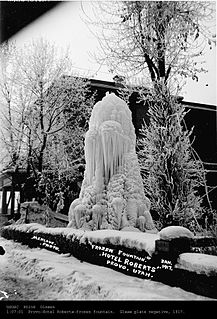
Hotel Roberts was a historic hotel located in central Provo, Utah, United States, that was formerly listed on the National Register of Historic Places.

The South End of Stamford, Connecticut is a rapidly growing neighborhood located at the southern end of the city, just south of the Downtown neighborhood. It is expected to be greatly changed with redevelopment over the next decade, including the massive Harbor Point redevelopment. The South End is a peninsula bordered by Stamford's Central Business District and Interstate 95 to the North and almost totally by water on all other sides, with few streets linking it to other neighborhoods. It contains some industrial tracts, several old factory buildings, many small homes and apartment buildings, and a number of office buildings. Most of the neighborhood has been designated as the South End Historic District which is listed on the National Register of Historic Places. A high-risk flood zone, Stamford's South End is the location of the Stamford Hurricane Protection Barrier, operated by the U.S. Army Corps of Engineers.
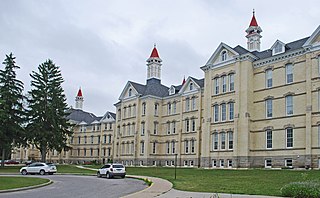
The Traverse City State Hospital of Traverse City, Michigan is a decommissioned psychiatric hospital that has been variously known as the Northern Michigan Asylum and the Traverse City Regional Psychiatric Hospital. It is the last Kirkbride Building of Michigan's original four left in the state. It was listed on the National Register of Historic Places in 1978 and designated a Michigan State Historic Site in 1985.

The First National Center, formerly known as First National Bank Building, is a prominent mixed-use skyscraper in downtown Oklahoma City. The art deco tower is 446 feet tall at the roof, and is 493 feet at its spire and contains 33 floors. The building was constructed in 1931 by the First National Bank and Trust Company of Oklahoma City and has 990,000 square feet (92,000 m2) of office space.

The Lena Water Tower is a water tower located in the village of Lena, Illinois, United States. It was built in 1896 following two decades of problems with structure fires in the village. The current water tower is the result of a second attempt after the first structure proved to be unstable. The tower stands 122.5 feet (37.3 m) tall and is built of limestone and red brick. The current stainless steel water tank holds 50,000 gallons and replaced the original wooden tank in 1984. The site has two other structures, an old power plant building and a 100,000 US gallon reservoir. The Lena Electric Plant Building was constructed in 1905 and the reservoir completed in 1907. The Lena Water Tower was listed on the U.S. National Register of Historic Places in 1997; the reservoir was included as a contributing property to the listing.

The Sears, Roebuck and Company Complex on the west side of Chicago, Illinois is where Sears conducted the bulk of its mail order operations between 1906 and 1993. It also served as the corporate headquarters until 1973, when the Sears Tower was completed. Of its original 40-acre (16 ha) complex, only three buildings now survive, and have been adaptively rehabilitated to other uses. The complex was designated a National Historic Landmark in 1978, at which time it still included the 3,000,000-square-foot mail order plant, the world's largest commercial building when it was completed. That building has been demolished, its site taken up by the Homan Square redevelopment project.

One Meridian Plaza was a 38-story high-rise office building in Philadelphia, Pennsylvania, United States. The 492-foot (150-meter) tower was designed by Vincent Kling & Associates and completed in 1972. The building was demolished in 1999, as a result of damage of a fire that began on February 23, 1991. The fire began on the 22nd floor and raged out of control for hours. An investigation of the fire, led by the Office of the Fire Marshal of the City of Philadelphia with assistance from the Bureau of Alcohol, Tobacco, Firearms and Explosives' (ATF) national investigative response team, determined the blaze started after linseed oil–soaked rags ignited. Philadelphia firefighters fought the blaze, but struggled due to a lack of power in the skyscraper and insufficient water pressure from the building's standpipes. Three firefighters died in the twelve-alarm fire after becoming disoriented by heavy smoke. Firefighting efforts inside One Meridian Plaza eventually were abandoned, due to fears the structure would collapse. The fire was only brought under control once it reached the 30th floor, which was one of the few floors that had automatic sprinklers installed. Ten sprinklers held back the fire until it started burning itself out and was finally brought under control almost a full day after it started. The blaze seriously damaged the building, destroying eight floors and damaging neighboring buildings.
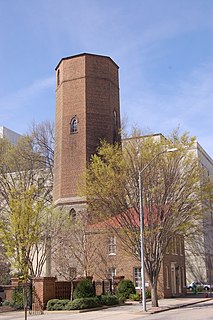
The Raleigh Water Tower is a historic building that was the first water tower built in Raleigh, North Carolina. Constructed in 1887, the City of Raleigh relied on the tower for 37 years until it was decommissioned in 1924. Formerly, the building was used as the headquarters for the North Carolina Chapter of the American Institute of Architects (AIA)., however it was recently sold to the law firm of Shirley & Adams. Shirley & Adams leased the tower out to be the headquarters for the franchise management company for Smithfield's Chicken 'N BBQ while the firm of Gammon, Howard & Zeszotarski, PLLC occupy the former firehouse at the back of the property. The Raleigh Water Tower was listed on the National Register of Historic Places in 1971 and is a Raleigh Historic Landmark. It is located in the Capitol Area Historic District.

Fall River Waterworks is a 22-acre (8.9 ha) historic site located at the eastern end Bedford Street in Fall River, Massachusetts, along the shore of North Watuppa Pond. The property, which is still used as a water works for the city, contains the original pumping station, intake house and 121-foot (37 m) tall standpipe water tower. The system was originally built between 1872 and 1875, and expanded or upgraded many times. It was added to the National Register of Historic Places in 1981.

The Old Warner Brothers Studio, officially called today Sunset Bronson Studios, is a motion picture, radio and television production facility located on Sunset Boulevard in Hollywood, California. The studio was the site where the first talking feature film, The Jazz Singer, was filmed in 1927.

The Brooks Catsup Bottle water tower, trademarked "The World's Largest Catsup Bottle", is a water tower south of Collinsville, Illinois. It is claimed to be the largest catsup bottle in the world. As a prime example of mid-20th-century novelty architecture, it is listed on the National Register of Historic Places. The tower is most notable in its capacity as a regional landmark and as a roadside attraction.
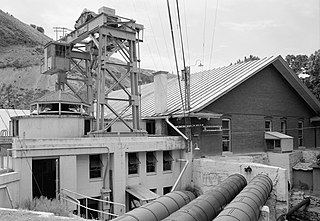
The Olmsted Power Station is a historic building located in Orem, Utah, United States. It is listed on the National Register of Historic Places. The hydropower plant was dedicated on April 12, 1904 and decommissioned on September 21, 2015. The plant will become a museum after a seismic refit of the building.

The Evansville Standpipe is a historic water tower located in Evansville, Wisconsin. The 80-ft tall steel tower was built in 1901 by the Chicago Bridge & Iron Company, as part of the development of the local water supply system, spurred on by a devastating fire in 1896 that destroyed a large section of downtown Evansville. It was added to the National Register of Historic Places in 2008.
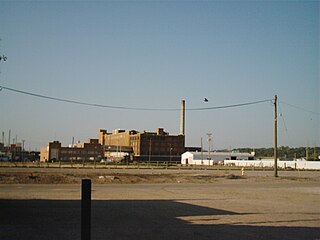
The Swift & Co. meatpacking plant in Sioux City, in the state of Iowa in the Midwestern United States, was built in 1918–19 as a speculative venture under the name Midland Packing Plant. After going into receivership, it was acquired by Swift & Co. in 1924, and continued to operate until 1974. It was then purchased by a Sioux City businessman and converted to an enclosed mall, the KD Stockyards Station. The building was listed in the National Register of Historic Places in 1979.

The H. Black and Company Building is a historic former factory building located in Cleveland, Ohio, in the United States. It was commissioned by H. Black and Company, one of the largest manufacturers of women's clothing in the United States, and designed by noted New York City architect Robert D. Kohn. Completed in 1907, it won national praise for its design. The building was sold in 1928 to the Evangelical Press, and for a short time was known as the Evangelical Press Building. The commercial printing business of the Evangelical Press was spun off as a secular company, Tower Press, in 1934, after which the structure became known as the Tower Press Building. Vacant for much of the 1960s and 1970s, the building had two different owners in the 1980s and was nearly demolished. A new owner took over the building in 2000, after which it underwent an award-winning renovation and restoration. The structure was added to the National Register of Historic Places on January 24, 2002. The structure now serves as a mixed-use development for low- and moderate-income artists.

The Western Knitting Mills is a former industrial building located at 400 Water Street in Rochester, Michigan. The building has been renovated to serve commercial tenants, including Rochester Mills Beer Company. It was listed on the National Register of Historic Places in 2000.
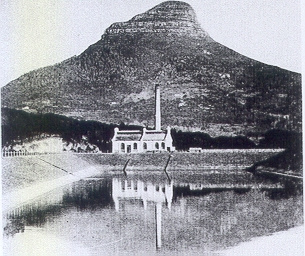
The Graaff Electric Lighting Works power station is a decommissioned Hydro-electric and steam power plant located in Cape Town, South Africa at the site of the Molteno Dam.
References
- ↑ "National Register Information System". National Register of Historic Places . National Park Service. July 9, 2010.
- 1 2 "National Register #78000741: Site of Utah Condensed Milk Company Plant in Galt, California". noehill.com. Retrieved 26 November 2013.
- 1 2 3 Hoge, Patrick (12 October 1993). "OWNER MAY FIGHT ORDER TO RAZE PLANT". The Sacramento Bee.
